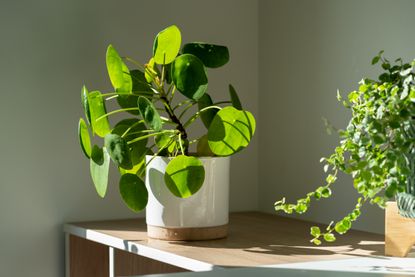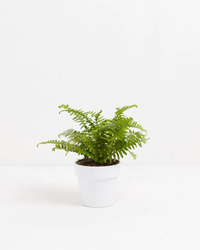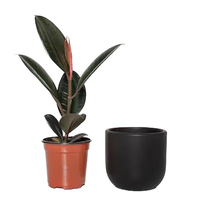'Too hot or cold and you risk damaging the plant' – this is the ideal watering temperature for healthy houseplants
This simple change could be the answer to having happier, healthier, and longer-living houseplants


Plant parenting is actually much like real-life parenting. Some of us stick to more rigid regimes with organized schedules while the rest (the majority) just take each day as it comes, adopting a much more chaotic approach as they grapple with the many demands of modern life. That's exactly why watering your houseplants is often treated as an afterthought.
Okay, feeding your kids definitely isn't something you'd forget to do, but the analogy still stands. Decorating with plants offers plenty of aesthetic benefits to your space, but being a plant parent comes with responsibility. We all know watering our plants is important, often even adapting new schedules to keep them thriving, but what you probably don't know is that water straight from the faucet might not be doing them any favors. That's because if the water's too cold, you can cause some serious, irreparable damage to your plants.
To find out exactly what temperature the water we feed our houseplants should be, we spoke with some plant experts who share their insights below. As it turns out, making this simple change might actually be the secret to happier, healthier, and longer-living plants...
Should you avoid watering your houseplants with cold water?

Most of us don't think twice about using water straight from the faucet to water our plants. It's quick, convenient, and gets the job done. The thing is, while your plants have probably gotten by just fine with water from a tap until now, they might thrive better with water that's been left to rest.
That's because the water that flows straight from the faucet is cold - an average of 55 degrees Fahrenheit to be exact, according to research by Scientific American - and those sorts of temperatures can really shock our indoor plants that are used to a lovely, ambient room temperature.
'For that reason, it's generally best to water your houseplants with room temperature water rather than cold water,' explains Mo Bhula, plant expert at the Botanical Archive. 'Room temperature water is ideal because it is less likely to shock the plant's root system or cause damage to the plant's cells. Too hot or too cold and you risk damaging the plant.'
What sort of damage are we talking about, then? Well, the most likely risk of using water that's too cold is a shock to the plant's root system, leading to slowed growth and possible root damage. 'It can also lead to the chilling of plant cells, which can result in wilting, discoloration, and potential cell damage,' adds Mo. 'There's also the risk of reduced nutrient uptake, as colder temperatures can slow down the plant's metabolic processes.' If you want to keep your best houseplants happy and healthy, cold water is a no-go.

Boston Fern, Lively Root
Bushy and beautiful, the humidity-loving Boston fern will add fairy-tale woodland charm to any space. These natural air purifiers work wonders in kitchens and bathrooms to suck up moisture, and look especially striking in a hanging container
Let your water reach room temperature

The question is, where do we draw the line? Just how cold is too cold? And how do we avoid going too far in the other direction? In short, the vast majority of houseplants will greatly prefer temperate water, which is water that's at or around room temperature. 'This is because, naturally, most rain falls within this temperature range,' says Mo.
Room temperature is considered anywhere between 68–72 degrees Fahrenheit, but the optimum temperature for houseplants' roots to absorb water and nutrients is in fact around the bottom of this range. 'In most cases though, water between 60 and 70 degrees will be just fine, but ideally you want the water to be around 65 degrees Fahrenheit,' says Joanna Turner of Fiddle and Thorn. 'Make sure to test it on your hand before giving it to your plants to make sure that it’s not extremely hot or cold.'
It's worth noting that watering your plants with hot water will be just as damaging, if not more so, as cold water. 'The hot water can very quickly burn the root system, killing the plant,' adds Joanna. 'Plants with thin, shallow root systems are particularly at risk and it’s crucial that they are given room temperature water.' The best way to ensure your water is around this temperature range? Simply leave a full jug of water or watering can out in your home overnight to rest and warm up.

Ficus houseplant, Lowes
The beautiful deep green foliage of the ficus plant has a red-ish tinge's especially striking thanks to its surface's shiny qualities. Its large leaves are notorious for collecting dust however, so be sure to wipe often.
Research the requirements of your individual plants

How often you water your houseplants will depend on the different types you own. The same goes for water temperature. While temperate water is generally always best, plants from different climates will have different preferences.
'It is often best to think about where your plant lives in nature when considering the water temperature,' explains Mo. 'Some topicals like Philodendrons or Monstera may prefer warmer water and some desert plants like succulents may tolerate things a bit cooler.'
For the most part, water from the faucet is fine but some rarer, tender plants like ghost orchids will also require special distilled water to keep them thriving. Brush up on your research and look up your plant's individual requirements if you're in any doubt.
Use the bottom watering method
Finally, cold water or general dampness on the foliage of your houseplant can cause leaves to rot or the formation of discolored spots. To avoid this, bottom watering your plants is a far safer method.
As you may have guessed, bottom watering simply involves adding a small amount of water to a saucer or tray beneath your plant pot which is then absorbed by your plant's roots. Not only does it avoid damage to your plant's foliage from cold water, but it can help reduce the risk of overwatering too as your plants will only absorb as much water as they need.
Be The First To Know
The Livingetc newsletter is your shortcut to the now and the next in home design. Subscribe today to receive a stunning free 200-page book of the best homes from around the world.

Lilith Hudson is the News Editor at Livingetc, and an expert at decoding trends and reporting on them as they happen. Writing news, features, and explainers for our digital platform, she's the go-to person for all the latest micro-trends, interior hacks, and color inspiration you need in your home. Lilith discovered a love for lifestyle journalism during her BA in English and Philosophy at the University of Nottingham where she spent more time writing for her student magazine than she did studying. After graduating, she decided to take things a step further and now holds an MA in Magazine Journalism from City, University of London, with previous experience at the Saturday Times Magazine, Evening Standard, DJ Mag, and The Simple Things Magazine. At weekends you'll find her renovating a tiny one-up, one-down annex next to her Dad's holiday cottage in the Derbyshire dales where she applies all the latest design ideas she's picked up through the week.
-
 These 12 Best Table Lamps for Your Desk — Perfect Glows for a Creative Home Office
These 12 Best Table Lamps for Your Desk — Perfect Glows for a Creative Home OfficeThe best table lamps for your desk is have a soft, targeted glow. Elevate your WFH set-up with these stylish picks endorsed by Style Editor Brigid Kennedy
By Brigid Kennedy Published
-
 The Nespresso VertuoPlus is 30% Off for President's Day, and it's Kim Kardashian's Coffee Maker of Choice
The Nespresso VertuoPlus is 30% Off for President's Day, and it's Kim Kardashian's Coffee Maker of ChoiceThis sleek and stylish coffee maker was spotted in Kim's home bar, and you can currently save $60 if you buy yours from Amazon
By Lilith Hudson Published

